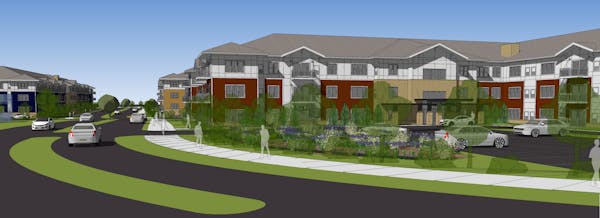For years, the roar of aircraft arriving and departing from Minneapolis-St. Paul International Airport was mostly contained to neighborhoods in south Minneapolis — the unavoidable byproduct of a busy airport situated so close to the city.
But research generated by the MSP FairSkies Coalition, a determined group of neighborhood activists, indicates that noise from the airport has increased 30 percent since 2014 and that its reach has spread to new corners of Minneapolis and the suburbs. St. Louis Park was hit hardest, with the number of people affected by aircraft noise increasing by 177 percent over the past two years, according to the group's analysis.
The coalition met earlier this summer at St. Louis Park City Hall, where its co-founders discussed noise contours, day-night average sound levels (or DNL, to those in the know) and other wonky aspects of airport noise.
The two dozen residents who attended scribbled notes and politely asked questions, until one woman exhaled in frustration: "I can't even have a conversation in the Byerlys parking lot!"
The Metropolitan Airports Commission (MAC), which operates MSP, says airport noise complaints increased about 4 percent between 2015 and 2016. The cause: more aircraft flying in and out of MSP, including more nighttime flights (which tend to bother people more).
Plus, new runway safety requirements at MSP have had a "notable effect" on noise, particularly in parts of southwest Minneapolis and St. Louis Park, said Chad Leqve, director of the MAC's Environment department.
"We kept hearing, 'The planes keep coming and coming — we don't get a break like we used to,' " Leqve said.
Anti-noise activists say the 40-year-old standard used by the Federal Aviation Administration (FAA) and the MAC to determine the impact of noise on neighborhoods is obsolete. The threshold is 65 decibels on the DNL metric.
The FairSkies Coalition claims the international standard of 55 decibels DNL is more accurate, though imperfect. At that rate, airport noise in the Twin Cities is far more pervasive.
"Over the years, how noise affects us has changed. We experience it differently," said Steve Kittleson, co-founder of the coalition.
The FAA is studying the issue. "We are sensitive to the growing public concerns about aircraft noise," said spokeswoman Elizabeth Isham Cory. "However, any changes to the metric must be accompanied by a sufficient body of scientific and technical justification."
N.O.I.S.E., a Washington, D.C. coalition of elected officials, says more study is needed to find the appropriate measurement. "DNL is an average and humans do not perceive noise in averages, but rather as individual events," the group said.
Jim Spensley, president of an anti-noise group called the South Metro Airport Action Council (SMAAC), said the current way of measuring noise "is completely undefined" and "has no useful or scientific basis." In addition, Spensley says it fails to account for the harmful effect of air traffic on the environment.
Kevin Terrell, co-founder of the MSP FairSkies Coalition, agrees. The measurement is "a way to start the conversation about noise" and how it affects health and wellness, as well as residents' property values, he said.
The metric is vitally important in one sense: It determines whether residents qualify for noise mitigation from the MAC — which may involve new windows, storm doors, insulation and central air conditioning. The MAC's standard to qualify for mitigation is 60 decibels DNL over a three-year period — beyond what the FAA requires.
Since 1992, the MAC has spent nearly $500 million on property acquisitions and home insulation for more than 18,000 residences and 18 schools within the airport's reach — a program regarded as one of the most extensive in the United States.
While acknowledging some residents may want their homes soundproofed, MSP FairSkies Coalition officials say their goal is to work with the MAC to squelch the din in other ways, such as curfews for airport use and fines for airlines that operate noisy aircraft.
"You can't insulate your yard, you can't insulate a park, or an outdoor cafe in the neighborhood," Kittleson said.
Terrell filed a Freedom of Information Act request with the FAA to get the data for his sound-contour map, which resulted in a $1,500 bill that was paid for by donations. Jeff Matson, at the University of Minnesota's Center for Urban and Regional Affairs, helped draw the new map.
It shows that nearly 100,000 people in the Twin Cities are negatively affected by airport noise.
"I don't think the MAC or FAA is necessarily hiding information, but they're not being as open and transparent as they could be about what's happening with noise," Matson said. "We have to have [the data] to have this discussion. Noise is shifting and more people are feeling the impact. People want to know why."
The group is pushing the MAC to produce its own version of the 55 dB DNL map, but Leqve said it would be too confusing to residents who want noise mitigation.
The battle over airport noise has intensified nationwide as the FAA rolls out NextGen, a $36 billion satellite-based system for managing air traffic. This has prompted complaints — and some cases, lawsuits — in Phoenix, San Francisco, Washington, D.C., and elsewhere as new flight paths emerge in neighborhoods unaccustomed to aircraft noise.
Last week, the U.S. Court of Appeals for the District of Columbia Circuit threw out the NextGen flight plan for Phoenix Sky Harbor International Airport. Neighbors argued the FAA did not properly analyze the effect of the new flight plan and failed to engage neighbors before its initial use in 2014.
Similar opposition surfaced in the Twin Cities over plans to change departure routes at MSP under NextGen, and the FAA backed off. But activists are worried the plans could resurface. They say having accurate data, including new noise maps, will help them fight back if the FAA reconsiders.
For now, the FAA said it has "no plans" to use the new navigation system for departures at MSP.

Minnesota Democrats announce deal on minimum pay for Uber and Lyft drivers

Twin Cities native Dolores Rosedale, glamorous '50s TV model and actress, dies at 95

Minnesota Legislature races toward deadline with bonding, rideshare bills in question

South metro program sweeps a tight set of adapted softball finals


